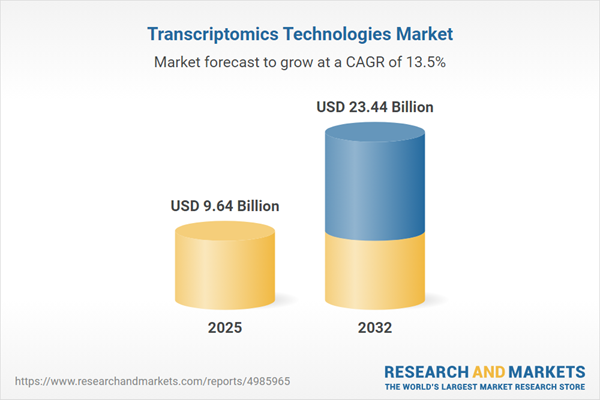Speak directly to the analyst to clarify any post sales queries you may have.
Transcriptomics technologies are transforming research and clinical practices across the life sciences sector. By equipping organizations with advanced data analysis and workflow tools, these solutions enable senior decision-makers to optimize R&D productivity, maintain regulatory agility, and guide business strategy amid evolving scientific demands.
Market Snapshot: Global Transcriptomics Technologies Market Growth
The global transcriptomics technologies market is undergoing substantial growth as organizations embrace cutting-edge gene expression techniques and innovative data methodologies. Reaching USD 8.48 billion in 2024, with a projection of USD 9.64 billion by 2025 and forecasts climbing to USD 23.44 billion in 2032, the market is propelled by a strong 13.53% compound annual growth rate.
Advances in high-throughput sequencing, and the rapid uptake of single-cell and spatial transcriptomics, are pivotal in accelerating adoption and performance. Industry leaders are revising funding frameworks and organizational processes to address regulatory evolution and seize emerging market opportunities. This climate highlights the need for robust planning and adaptability to secure a strategic advantage and ensure compliance.Scope & Segmentation in the Transcriptomics Technologies Market
Comprehensive segmentation enables executive teams to identify high-return investment areas, streamline compliance, and target scalable innovation. Senior decision-makers can align resources precisely with prevailing demand, technology shifts, and regional opportunities.
- Product Types: Portfolio includes benchtop sequencing instruments, high-throughput platforms, cDNA synthesis kits, RNA extraction solutions, next-generation sequencing kits, and advanced bioinformatics tools, serving both clinical and research applications while supporting data quality and traceability.
- Technologies: Core offerings such as next-generation sequencing, quantitative real-time PCR, and in situ hybridization enhance discovery to clinical translation, supporting end-to-end project workflows and offering in-depth genomic insights.
- Applications: Broad use cases encompass gene expression profiling, biomarker discovery, drug development, and both single-cell and bulk transcriptomics. This versatility enables progress in personalized medicine and propels value across all phases of R&D.
- End Users: Customer base includes academic institutions, research laboratories, diagnostics providers, hospitals, and biopharma enterprises, all of whom require robust platforms and expert support during research design, analytical processing, and clinical validation.
- Geographies: Strategic market activity spans the Americas, Europe, Middle East, Africa, and Asia-Pacific. Navigating regional regulations, adapting to local requirements, and managing supply chain challenges remain central for sustained leadership and minimized risk.
This detailed segmentation framework assists organizations in shaping innovation pipelines, supporting regulatory adherence, and advancing cross-regional growth objectives in transcriptomics technologies.
Key Takeaways for Senior Decision-Makers
- Integration of single-cell RNA sequencing increases precision in molecular analysis, strengthening the basis for targeted therapies and enhancing risk management throughout R&D initiatives.
- Applying artificial intelligence and machine learning to transcriptomics platforms accelerates the processing of complex datasets, which improves efficiency and analytical accuracy as laboratory and clinical sample sizes scale.
- Spatial transcriptomics delivers deeper tissue-level gene expression data, directly advancing translational research and supporting detailed experimental planning.
- Enhancing supply chain resilience is crucial for sustained compliance and stability, especially amid shifting regulatory requirements and operational disruptions.
- Collaboration between sectors, including partnerships across diagnostics and research, accelerates the uptake of new transcriptomics solutions and delivers greater operational efficiencies.
- Targeted investments in critical infrastructure and strategic alliances improve organizational agility, allowing timely responses to industry or regulatory shifts.
Tariff Impact on Global Supply Chains
Recent changes in U.S. tariff structures have increased complexities for sourcing transcriptomics equipment and reagents. Suppliers are responding by expanding domestic manufacturing and diversifying distribution, helping to contain operational costs. In turn, purchasing departments focus on greater procurement transparency, while service providers update pricing models for ongoing competitiveness. Heightened supply chain visibility and flexible management strategies are now vital for compliance and research continuity.
Methodology & Data Sources
This report integrates executive interviews with molecular biology experts, in-depth literature reviews, proprietary data analysis models, monitoring of patent activity, and validation against procurement standards. These sources ensure reliable, timely insights for professionals in the transcriptomics technologies sector.
Why This Report Matters: Strategic Value for Senior Leaders
- Empowers executive teams to anticipate market trends and drive strategic investment in transcriptomics technologies.
- Provides actionable guidance to navigate regulatory changes, optimize operational workflows, and reinforce resilient supply chains.
- Accelerates adoption of innovative platforms, fostering collaboration and supporting progress from early research to clinical deployment.
Conclusion
Leveraging actionable market intelligence equips organizations with the agility to respond to change and inform strategic planning. Leaders who act on these insights will be positioned to guide continued growth and maintain industry relevance as transcriptomics technologies advance.
Additional Product Information:
- Purchase of this report includes 1 year online access with quarterly updates.
- This report can be updated on request. Please contact our Customer Experience team using the Ask a Question widget on our website.
Table of Contents
3. Executive Summary
4. Market Overview
7. Cumulative Impact of Artificial Intelligence 2025
Companies Mentioned
The companies profiled in this Transcriptomics Technologies market report include:- Illumina, Inc.
- Thermo Fisher Scientific Inc.
- Agilent Technologies, Inc.
- QIAGEN N.V.
- 10x Genomics, Inc.
- Bio-Rad Laboratories, Inc.
- Roche Holding AG
- Pacific Biosciences of California, Inc.
- Oxford Nanopore Technologies Limited
- Fluidigm Corporation
Table Information
| Report Attribute | Details |
|---|---|
| No. of Pages | 197 |
| Published | October 2025 |
| Forecast Period | 2025 - 2032 |
| Estimated Market Value ( USD | $ 9.64 Billion |
| Forecasted Market Value ( USD | $ 23.44 Billion |
| Compound Annual Growth Rate | 13.5% |
| Regions Covered | Global |
| No. of Companies Mentioned | 11 |









